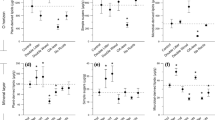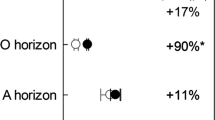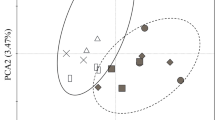Abstract
With climate change, forests are expected to receive increased inputs of carbon (C) and nitrogen (N) but it is unclear how this will modify forest C cycling and storage at the molecular-level. To investigate the response of forest soil organic matter (SOM) to changes in soil inputs, a study area was established in a Michigan hardwood forest as part of the Detrital Input and Removal Treatments (DIRT) network. Experimental treatments were comprised of both exclusions of detrital inputs (No Litter, No Roots, No Inputs) and additions of C and N (Double Litter, N-Addition, Double Litter + N, Wood). After 10 years of treatment, the soils were characterized using elemental analysis, molecular biomarker techniques, nuclear magnetic resonance spectroscopy, and microbial biomass C measurements. Although manipulation of detrital inputs did not significantly change the soil C and N content after 10 years, alterations in the cycling and distribution of SOM components were observed. Root exclusion enhanced SOM degradation, while doubling litter favoured the degradation of more labile forms of soil C such as unsaturated n-alkanoic acids and simple sugars. N-Addition and Double Litter + N increased the concentrations of extractable biomarkers, including aliphatic and cyclic lipids and compounds derived from cutin, suberin, and lignin. Microbial biomass C also varied with experimental litter input manipulations and N addition, and these data were consistent with the observed changes in SOM composition. Overall, the observed shifts in SOM chemistry after 10 years of manipulating ecosystem inputs highlight the sensitivity of natural systems to changes in amounts of C and N inputs from roots and litter, and N inputs from external sources.



Similar content being viewed by others
References
Allison SD, Martiny JBH (2008) Resistance, resilience, and redundancy in microbial communities. Proc Natl Acad Sci 105:11512–11519
Baldock JA, Oades JM, Waters AG et al (1992) Aspects of the chemical structure of soil organic materials as revealed by solid-state 13C NMR spectroscopy. Biogeochemistry 16:1–42
Blanchette RA (1984) Screening wood decayed by white rot fungi for preferential lignin degradation. Appl Environ Microbiol 48:647–653
Bonan GB (2008) Forests and climate change: forcings, feedbacks, and the climate benefits of forests. Science 320:1444–1449
Bowden RD, Deem L, Plante AF et al (2014) Litter input controls on soil carbon in a temperate deciduous forest. Soil Sci Soc Am J 78:S66–S75
Brant JB, Sulzman EW, Myrold DD (2006) Microbial community utilization of added carbon substrates in response to long-term carbon input manipulation. Soil Biol Biochem 38:2219–2232
Campbell MM, Sederoff RR (1996) Variation in lignin content and composition (Mechanisms of control and implications for the genetic improvement of plants). Plant Physiol 110:3–13
Carreiro MM, Sinsabaugh RL, Repert DA, Parkhurst DF (2000) Microbial enzyme shifts explain litter decay responses to simulated nitrogen deposition. Ecology 81:2359
Carrington EM, Hernes PJ, Dyda RY et al (2012) Biochemical changes across a carbon saturation gradient: lignin, cutin, and suberin decomposition and stabilization in fractionated carbon pools. Soil Biol Biochem 47:179–190
Clemmensen KE, Bahr A, Ovaskainen O et al (2013) Roots and associated fungi drive long-term carbon sequestration in Boreal Forest. Science 339:1615–1618
Conte P, Spaccini R, Piccolo A (2004) State of the art of CPMAS 13C-NMR spectroscopy applied to natural organic matter. Prog Nucl Magn Reson Spectrosc 44:215–223
Crow SE, Lajtha K, Bowden RD et al (2009a) Increased coniferous needle inputs accelerate decomposition of soil carbon in an old-growth forest. For Ecol Manage 258:2224–2232
Crow SE, Lajtha K, Filley TR et al (2009b) Sources of plant-derived carbon and stability of organic matter in soil: implications for global change. Glob Chang Biol 15:2003–2019
Donnelly PK, Entry JA, Crawford DL, Cromack K (1990) Cellulose and lignin degradation in forest soils: response to moisture, temperature, and acidity. Microb Ecol 20:289–295
Ertel JR, Hedges JI (1984) The lignin component of humic substances: distribution among soil and sedimentary humic, fulvic, and base-insoluble fractions. Geochim Cosmochim Acta 48:2065–2074
Fenn P, Kirk KT (1981) Relationship of nitrogen to the onset and suppression of ligninolytic activity and secondary metabolism in Phanerochaete chrysosporium. Arch Microbiol 130:59–65
Fontaine S, Barot S, Barré P et al (2007) Stability of organic carbon in deep soil layers controlled by fresh carbon supply. Nature 450:277–280
Fox TR, Comerford NB (1990) Low-molecular-weight organic acids in selected forest soils of the Southeastern USA. Soil Sci Soc Am J 54:1139–1144
Frey SD, Knorr M, Parrent JL, Simpson RT (2004) Chronic nitrogen enrichment affects the structure and function of the soil microbial community in temperate hardwood and pine forests. For Ecol Manage 196:159–171
Frey SD, Ollinger S, Nadelhoffer K et al (2014) Chronic nitrogen additions suppress decomposition and sequester soil carbon in temperate forests. Biogeochemistry 121:305–316
Gonçalves CN, Dalmolin RSD, Dick DP et al (2003) The effect of 10% HF treatment on the resolution of CPMAS 13C NMR spectra and on the quality of organic matter in Ferralsols. Geoderma 116:373–392
Goñi MA, Hedges JI (1992) Lignin dimers: structures, distribution, and potential geochemical applications. Geochim Cosmochim Acta 56:4025–4043
Grant WD, West AW (1986) Measurement of ergosterol, diaminopimelic acid and glucosamine in soil: evaluation as indicators of microbial biomass. J Microbiol Methods 6:47–53
Harmon ME, Franklin JF, Swanson FJ, Sollins P, Gregory V, Lattin JD, Anderson NH, Clinen SP, Aumen G, Sedell JR, Lienkaemperk GW, Cromack K, Cummins KW (2004) Ecology of coarse woody debris in temperate ecosystems. Adv Ecol Res 34:59–234
Hedges JI, Ertel JR (1982) Characterization of lignin by gas capillary chromatography of cupric oxide oxidation products. Anal Chem 54:174–178
Hedges JI, Mann DC (1979) The characterization of plant tissues by their lignin oxidation products. Geochim Cosmochim Acta 43:1803–1807
Heim A, Schmidt MWI (2007) Lignin turnover in arable soil and grassland analysed with two different labelling approaches. Eur J 58:599–608
Hempfling R, Ziegler F, Zech W, Schulten H-R (1987) Litter decomposition and humification in acidic forest soils studied by chemical degradation, IR and NMR spectroscopy and pyrolysis field ionization mass spectrometry. Z Pflanzenernähr Bodenkd 150:179–186
Jandl R, Lindner M, Vesterdal L et al (2007) How strongly can forest management influence soil carbon sequestration? Geoderma 137:253–268
Jenkinson DS, Powlson DS (1976) The effects of biocidal treatments on metabolism in soil—I. Fumigation with chloroform. Soil Biol Biochem 8:167–177
Kaplan JO, Krumhardt KM, Zimmermann NE (2012) The effects of land use and climate change on the carbon cycle of Europe over the past 500 years. Glob Chang Biol 18:902–914
Knicker H, Lüdemann HD (1995) N-15 and C-13 CPMAS and solution NMR studies of N-15 enriched plant material during 600 days of microbial degradation. Org Geochem 23:329–341
Kögel-Knabner I (1997) 13C and 15N NMR spectroscopy as a tool in soil organic matter studies. Geoderma 80:243–270
Kögel-Knabner I (2002) The macromolecular organic composition of plant and microbial residues as inputs to soil organic matter. Soil Biol Biochem 34:139–162
Kolattukudy PE (1970) Plant waxes. Lipids 5:259–275
Lagomarsino A, Moscatelli MC, De Angelis P, Grego S (2006) Labile substrates quality as the main driving force of microbial mineralization activity in a poplar plantation soil under elevated CO2 and nitrogen fertilization. Sci Total Environ 372:256–265
Lajtha K, Bowden RD, Nadelhoffer K (2014a) Litter and root manipulations provide insights into soil organic matter dynamics and stability. Soil Sci Soc Am J 78:S261–S269
Lajtha K, Townsend KL, Kramer MG et al (2014b) Changes to particulate versus mineral-associated soil carbon after 50 years of litter manipulation in forest and prairie experimental ecosystems. Biogeochemistry 119:341–360
Lajtha K, Bowden RD, Crow S et al (2018) The detrital input and removal treatment (DIRT) network: insights into soil carbon stabilization. Sci Total Environ 640–641:1112–1120
Lal R (2005) Forest soils and carbon sequestration. For Ecol Manage 220:242–258
Lehmann J, Kleber M (2015) The contentious nature of soil organic matter. Nature 528:60–68
Lehmann J, Kinyangi J, Solomon D (2007) Organic matter stabilization in soil microaggregates: implications from spatial heterogeneity of organic carbon contents and carbon forms. Biogeochemistry 85:45–57
Lewis D, Castellano M, Kaye J (2014) Forest succession, soil carbon accumulation, and rapid nitrogen storage in poorly remineralized soil organic matter. Ecology 95:2687–2693
Lichtfouse É, Berthier G, Houot S et al (1995) Stable carbon isotope evidence for the microbial origin of C14-C18 n-alkanoic acids in soils. Org Geochem 23:849–852
Melillo JM (2002) Soil warming and carbon-cycle feedbacks to the climate system. Science 298:2173–2176
Melillo JM, Butler S, Johnson J et al (2011) Soil warming, carbon-nitrogen interactions, and forest carbon budgets. Proc Natl Acad Sci 108:9508–9512
Nave LE, Vance ED, Swanston CW, Curtis PS (2009a) Impacts of elevated N inputs on north temperate forest soil C storage, C/N, and net N-mineralization. Geoderma 153:231–240
Nave LE, Vogel CS, Gough CM, Curtis PS (2009b) Contribution of atmospheric nitrogen deposition to net primary productivity in a northern hardwood forest. Can J For Res 39:1108–1118
Nordén B, Berg B (1990) A non-destructive method (solid state 13C NMR) for determining organic chemical components of decomposing litter. Soil Biol Biochem 22:271–275
Otto A, Simpson MJ (2005) Degradation and preservation of vascular plant-derived biomarkers in grassland and forest soils from Western Canada. Biogeochemistry 74:377–409
Otto A, Simpson MJ (2006a) Sources and composition of hydrolysable aliphatic lipids and phenols in soils from western Canada. Org Geochem 37:385–407
Otto A, Simpson MJ (2006b) Evaluation of CuO oxidation parameters for determining the source and stage of lignin degradation in soil. Biogeochemistry 80:121–142
Pinto P, Borges da Silva EA, Rodrigues AE (2010) Comparative study of solid-phase extraction and liquid-liquid extraction for the reliable quantification of high value added compounds from oxidation processes. Ind Eng Chem Res 49:12311–12318
Pisani O, Lin LH, Lun OOY et al (2016) Long-term doubling of litter inputs accelerates soil organic matter degradation and reduces soil carbon stocks. Biogeochemistry 127:1–14
Preston CM (2001) Carbon-13 solid-state NMR of soil organic matter—using the technique effectively. Can J Soil Sci 81:255–270
Preston CM (2014) Environmental NMR: solid-state methods. eMagRes 3:29–42
Qiao N, Schaefer D, Blagodatskaya E et al (2014) Labile carbon retention compensates for CO2 released by priming in forest soils. Glob Chang Biol 20:1943–1954
Rasse DP, Rumpel C, Dignac MF (2005) Is soil carbon mostly root carbon? Mechanisms for a specific stabilisation. Plant Soil 269:341–356
Rumpel C, Rabia N, Derenne S et al (2006) Alteration of soil organic matter following treatment with hydrofluoric acid (HF). Org Geochem 37:1437–1451
Savage KE, Parton WJ, Davidson EA et al (2013) Long-term changes in forest carbon under temperature and nitrogen amendments in a temperate northern hardwood forest. Glob Chang Biol 19:2389–2400
Schimel DS, Braswell BH, Holland EA et al (1994) Climatic, edaphic, and biotic controls over storage and turnover of carbon in soils. Global Biogeochem Cycles 8:279–293
Schmidt MWI, Torn MS, Abiven S et al (2011) Persistence of soil organic matter as an ecosystem property. Nature 478:49–56
Simoneit BRT, Grimalt JO, Wang TG et al (1986) Cyclic terpenoids of contemporary resinous plant detritus and of fossil woods, ambers and coals. Org Geochem 10:877–889
Spielvogel S, Prietzel J, Leide J et al (2014) Distribution of cutin and suberin biomarkers under forest trees with different root systems. Plant Soil 381:95–110
Stockmann U, Adams MA, Crawford JW et al (2013) The knowns, known unknowns and unknowns of sequestration of soil organic carbon. Agric Ecosyst Environ 164:80–99
Sulzman EW, Brant JB, Bowden RD, Lajtha K (2005) Contribution of aboveground litter, belowground litter, and rhizosphere respiration to total soil CO2 efflux in an old growth coniferous forest. Biogeochemistry 73:231–256
Thomas RQ, Canham CD, Weathers KC, Goodale CL (2010) Increased tree carbon storage in response to nitrogen deposition in the US. Nat Geosci 3:13–17
Vance ED, Brookes PC, Jenkinson DS (1987) Microbial biomass measurement in forest soils: the use of the chloroform fumigation-incubation method in stringly acid soils. Soil Biol Biochem 19:697–702
Vestal JR, White DC (1989) Lipid analysis in microbial ecology: quantitative approaches to the study of microbial communities. Bioscience 39:535–541
Wen-Yen H, Meinschein WG (1976) Sterols as source indicators of organic materials in sediments. Geochim Cosmochim Acta 40:323–330
Whittinghill KA, Currie WS, Zak DR et al (2012) Anthropogenic N deposition increases soil C storage by decreasing the extent of litter decay: analysis of field observations with an ecosystem model. Ecosystems 15:450–461
Wilson DB (2011) Microbial diversity of cellulose hydrolysis. Curr Opin Microbiol 14:259–263
Zak DR, Holmes WE, Burton AJ et al (2008) Simulated atmospheric NO3 − deposition increases organic matter by slowing decomposition. Ecol Appl 18:2016–2027
Acknowledgements
The authors thank Mel Knorr at the University of New Hampshire for completing the microbial biomass measurements as well as Fatima Sultani and Dr Ronald Soong at the University of Toronto Scarborough for assistance with soil extraction and NMR acquisition, respectively. M.J.S. thanks Natural Sciences and Engineering Research Council of Canada (NSERC) for a Discovery Grant (#2015-05760) and a Discovery Accelerator Supplement (#478038-15). L.V. would like to thank NSERC for a Canada Graduate Scholarship. Funding for the experimental plots at the UMBS was provided by internal sources.
Author information
Authors and Affiliations
Corresponding author
Additional information
Responsible Editor: Susan E. Crow
Electronic supplementary material
Below is the link to the electronic supplementary material.
Rights and permissions
About this article
Cite this article
vandenEnden, L., Frey, S.D., Nadelhoffer, K.J. et al. Molecular-level changes in soil organic matter composition after 10 years of litter, root and nitrogen manipulation in a temperate forest. Biogeochemistry 141, 183–197 (2018). https://doi.org/10.1007/s10533-018-0512-4
Received:
Accepted:
Published:
Issue Date:
DOI: https://doi.org/10.1007/s10533-018-0512-4




